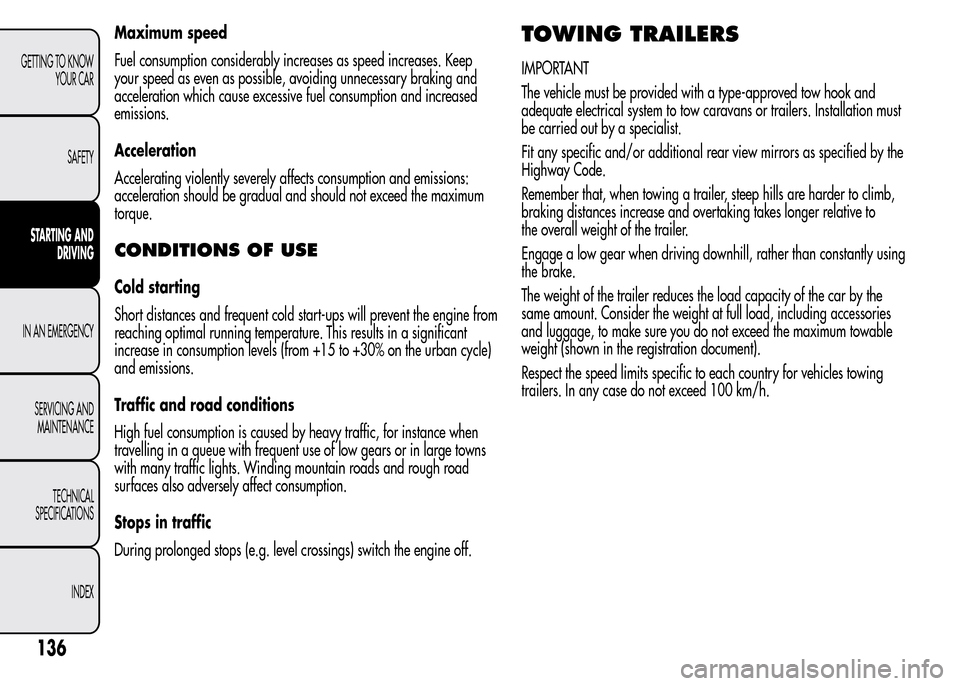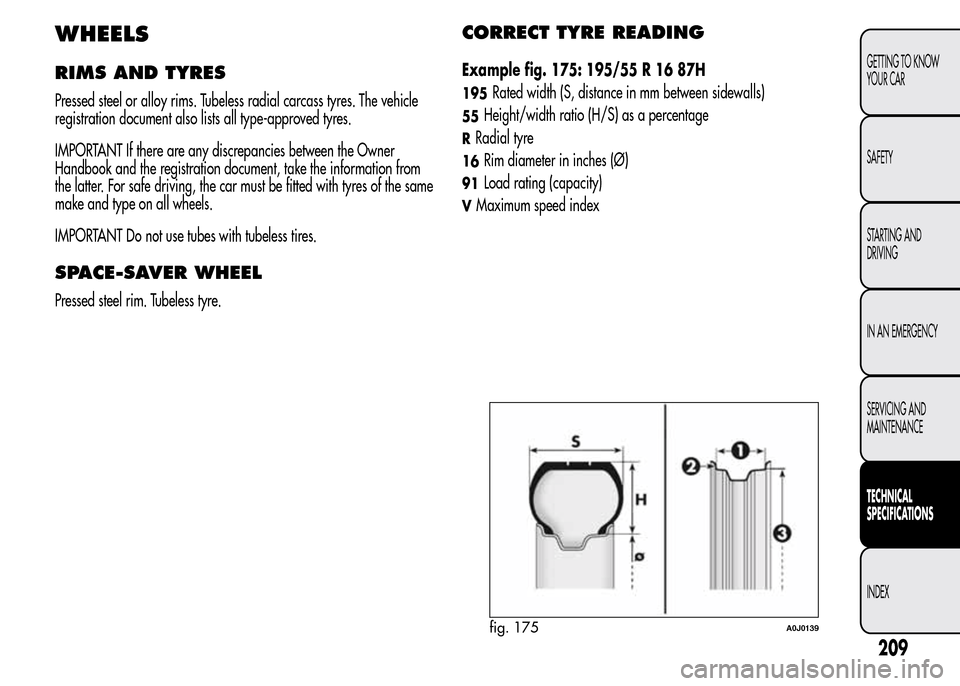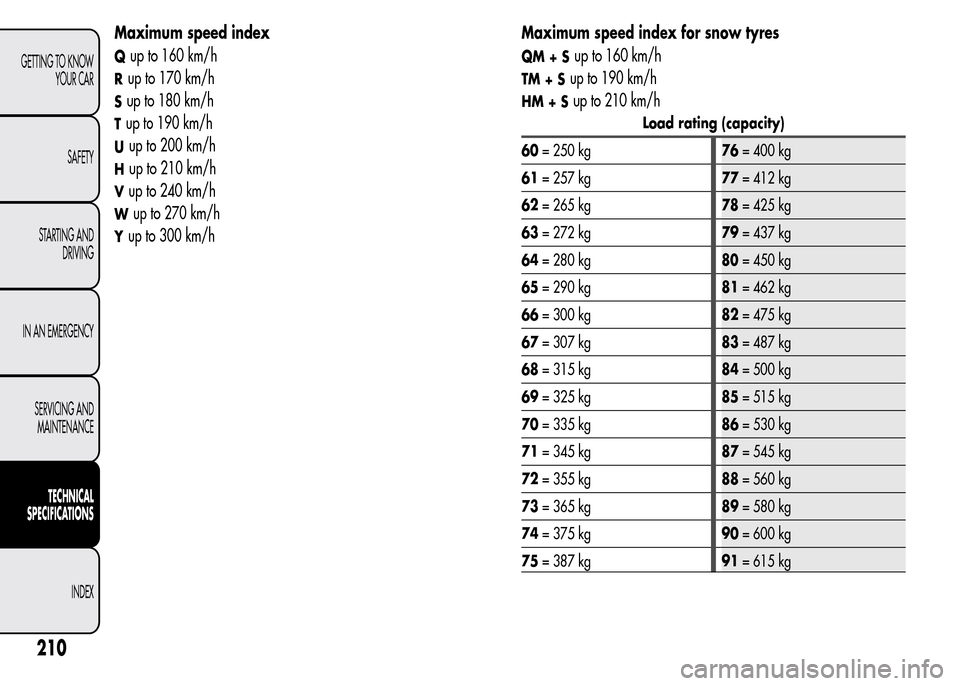load capacity Alfa Romeo MiTo 2015 Owner's Manual
[x] Cancel search | Manufacturer: ALFA ROMEO, Model Year: 2015, Model line: MiTo, Model: Alfa Romeo MiTo 2015Pages: 280, PDF Size: 8.52 MB
Page 140 of 280

Maximum speed
Fuel consumption considerably increases as speed increases. Keep
your speed as even as possible, avoiding unnecessary braking and
acceleration which cause excessive fuel consumption and increased
emissions.
Acceleration
Accelerating violently severely affects consumption and emissions:
acceleration should be gradual and should not exceed the maximum
torque.
CONDITIONS OF USE
Cold starting
Short distances and frequent cold start-ups will prevent the engine from
reaching optimal running temperature. This results in a significant
increase in consumption levels (from +15 to +30% on the urban cycle)
and emissions.
Traffic and road conditions
High fuel consumption is caused by heavy traffic, for instance when
travelling in a queue with frequent use of low gears or in large towns
with many traffic lights. Winding mountain roads and rough road
surfaces also adversely affect consumption.
Stops in traffic
During prolonged stops (e.g. level crossings) switch the engine off.
TOWING TRAILERS
IMPORTANT
The vehicle must be provided with a type-approved tow hook and
adequate electrical system to tow caravans or trailers. Installation must
be carried out by a specialist.
Fit any specific and/or additional rear view mirrors as specified by the
Highway Code.
Remember that, when towing a trailer, steep hills are harder to climb,
braking distances increase and overtaking takes longer relative to
the overall weight of the trailer.
Engage a low gear when driving downhill, rather than constantly using
the brake.
The weight of the trailer reduces the load capacity of the car by the
same amount. Consider the weight at full load, including accessories
and luggage, to make sure you do not exceed the maximum towable
weight (shown in the registration document).
Respect the speed limits specific to each country for vehicles towing
trailers. In any case do not exceed 100 km/h.
136
GETTING TO KNOW
YOUR CAR
SAFETY
STARTING AND
DRIVING
IN AN EMERGENCY
SERVICING AND
MAINTENANCE
TECHNICAL
SPECIFICATIONS
INDEX
Page 213 of 280

WHEELS
RIMS AND TYRES
Pressed steel or alloy rims. Tubeless radial carcass tyres. The vehicle
registration document also lists all type-approved tyres.
IMPORTANT If there are any discrepancies between the Owner
Handbook and the registration document, take the information from
the latter. For safe driving, the car must be fitted with tyres of the same
make and type on all wheels.
IMPORTANT Do not use tubes with tubeless tires.
SPACE-SAVER WHEEL
Pressed steel rim. Tubeless tyre.
CORRECT TYRE READING
Example fig. 175: 195/55 R 16 87H
195Rated width (S, distance in mm between sidewalls)
55Height/width ratio (H/S) as a percentage
RRadial tyre
16Rim diameter in inches (Ø)
91Load rating (capacity)
VMaximum speed index
fig. 175A0J0139
209
GETTING TO KNOW
YOUR CAR
SAFETY
STARTING AND
DRIVING
IN AN EMERGENCY
SERVICING AND
MAINTENANCE
TECHNICAL
SPECIFICATIONS
INDEX
Page 214 of 280

Maximum speed index
Qup to 160 km/h
Rup to 170 km/h
Sup to 180 km/h
Tup to 190 km/h
Uup to 200 km/h
Hup to 210 km/h
Vup to 240 km/h
Wup to 270 km/h
Yup to 300 km/hMaximum speed index for snow tyres
QM+Sup to 160 km/h
TM + Sup to 190 km/h
HM+Sup to 210 km/h
Load rating (capacity)
60= 250 kg76= 400 kg
61= 257 kg77= 412 kg
62= 265 kg78= 425 kg
63= 272 kg79= 437 kg
64= 280 kg80= 450 kg
65= 290 kg81= 462 kg
66= 300 kg82= 475 kg
67= 307 kg83= 487 kg
68= 315 kg84= 500 kg
69= 325 kg85= 515 kg
70= 335 kg86= 530 kg
71= 345 kg87= 545 kg
72= 355 kg88= 560 kg
73= 365 kg89= 580 kg
74= 375 kg90= 600 kg
75= 387 kg91= 615 kg
210
GETTING TO KNOW
YOUR CAR
SAFETY
STARTING AND
DRIVING
IN AN EMERGENCY
SERVICING AND
MAINTENANCE
TECHNICAL
SPECIFICATIONS
INDEX